| Empire of Brazil Império do Brasil Timeline: Differently
OTL equivalent: Brazil, French Guiana, Uruguay | ||||||
|---|---|---|---|---|---|---|
|
||||||
| Motto: Independência ou Morte! "Independence or Death!" |
||||||
| Anthem: Hino Nacional Brasileiro "National Anthem of Brazil" Royal anthem: Independência ou Morte "Independence or Death!" |
||||||
| Location of Brazil (green)
|
||||||
| Capital | Brasília | |||||
| Largest city | São Paulo | |||||
| Official languages | Portuguese | |||||
| Other languages | Spanish (co-official in Cisplatina) French (co-official in Amapá) |
|||||
| Religion | 70.7% Roman Catholicism (official) 21.2% Protestantism 2.7% other Christian 1.8% Spiritism and Umbanda 3.4% other/none |
|||||
| Government | Federal parliamentary constitutional monarchy | |||||
| - | Emperor | Luiz II | ||||
| - | Prime Minister | Soraya Thronicke | ||||
| Legislature | National Congress | |||||
| - | Upper house | Senate | ||||
| - | Lower house | Chamber of Deputies | ||||
| Independence from Portugal | ||||||
| - | Declared | 7 September 1822 | ||||
| - | Constitution | 25 March 1824 | ||||
| - | Independence recognised | 29 August 1825 | ||||
| Area | ||||||
| - | Total | 8,775,516 km2 3,388,246 sq mi |
||||
| Population | ||||||
| - | Estimate | 215,602,815 (4th) | ||||
| Currency | Real (Réis) | |||||
| Drives on the | right | |||||
Brazil (Portuguese: Brasil), officially the Empire of Brazil (Portuguese: Império do Brasil), is a country in eastern South America. At 8.7 million square kilometers and with over 215.6 million inhabitants, it is the largest and most populous country in South America and in all of the Americas. In global rankings, it stands as the world's second-largest and fourth-most populous nation. Brazil is also the only Portuguese-speaking country in the Americas and the only monarchy in South America. The culturally and ethnically diverse empire is a union composed of 30 provinces. The capital is Brasília, located on top of the country's highlands, the largest city is São Paulo, and other large and important cities include Rio de Janeiro, Belo Horizonte, Salvador, Curitiba, Recife, Porto Alegre, Montevidéu, Goiânia, Manaus, Belém and Fortaleza.
Brazil is bounded by the Atlantic Ocean on the east, borders Guyana and Suriname to the north and six Spanish-speaking republics to the west, namely Venezuela, Colombia, Peru, Bolivia, Paraguay, and Argentina. It is a megadiverse country, with a vast wildlife and a variety of ecological systems and natural resources. Brazil's climate is mostly tropical and subtropical, but there are also some areas with semi-arid and mountainous climates.
At the time of discovery by the Portuguese in the early 16th century, the region of present-day Brazil was home to thousands of different Amerindian peoples. Portugal established and maintained a colony in the country until 1808, when the two countries formed a union. The Portuguese presence in Brazil led to the Brazilian War of Independence, with the country becoming a separate sovereign state in 1825. Since then, Brazil became a prosperous local power and has played a major role in international politics. There were numerous internal wars in the 19th century, but the country achieved stability in the 1920s.
Brazil is a member of the League of Nations and BRAC.
History[]
Pre-colonial era[]
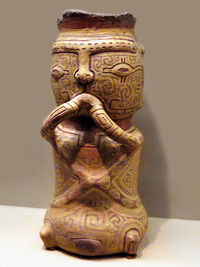
A Marajoara burial urn
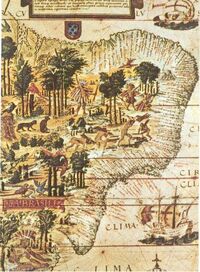
Terra Brasilis, a map of Brazil shortly after the arrival of the Portuguese
Some of the earliest human remains found in the Americas, such as Luzia Woman, were found in the area of Pedro Leopoldo, Minas Gerais and provide evidence of human habitation going back at least 11,000 years.
The earliest pottery ever found in the Western Hemisphere was excavated in the Amazon basin of Brazil and radiocarbon dated to 8,000 years ago (6000 BC). The pottery was found near Sãtarém, Pará and provides evidence that the tropical forest region supported a complex prehistoric culture. The Marajoara culture flourished on Marajó in the Amazon delta from 800 CE to 1400 CE, developing sophisticated pottery, social stratification, large populations, mound building, and complex social formations such as chiefdoms.
Around the time of the Portuguese arrival, the territory of current day Brazil had an estimated indigenous population of 7 million people, mostly semi-nomadic, who subsisted on hunting, fishing, gathering, and migrant agriculture. The indigenous population of Brazil comprised several large indigenous ethnic groups (e.g. the Tupi people, Guaranis, Gês and Arawaks). The Tupi people were subdivided into the Tupiniquins and Tupinambás, and there were also many subdivisions of the other groups.
Before the arrival of the Europeans, the boundaries between these groups and their subgroups were marked by wars that arose from differences in culture, language and moral beliefs. These wars also involved large-scale military actions on land and water, with cannibalistic rituals on prisoners of war. While heredity had some weight, leadership status was more subdued over time, than allocated in succession ceremonies and conventions. Slavery among the Indians had a different meaning than it had for Europeans, since it originated from a diverse socioeconomic organisation, in which asymmetries were translated into kinship relations.
Colonial Brazil[]
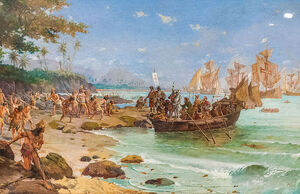
Pedro Álvares Cabral and his fleet arrive in Porto Seguro, 1500.
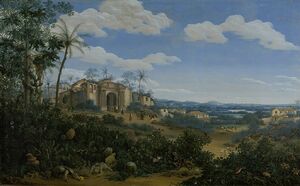
Olinda, Pernambuco, c. 1660
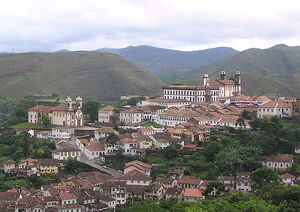
Ouro Preto, Minas Gerais, with typical 18th-century architecture
The land now called Brazil was claimed for the Portuguese Empire on 22 April 1500, with the arrival of the Portuguese fleet commanded by Pedro Álvares Cabral. The Portuguese encountered indigenous peoples divided into several tribes, most of whom spoke languages of the Tupi–Guarani family, and fought among themselves. Though the first settlement was founded in 1532, colonisation effectively began in 1534, when King John III of Portugal divided the territory into the fifteen private and autonomous Captaincy Colonies of Brazil.
However, the decentralized and unorganized tendencies of the captaincy colonies proved problematic, and in 1549 the Portuguese king restructured them into the Governorate General of Brazil, a single and centralized Portuguese colony in South America. In the first two centuries of colonisation, Indigenous and European groups lived in constant war, establishing opportunistic alliances in order to gain advantages against each other. By the mid-16th century, cane sugar had become Brazil's most important export, and slaves purchased in Sub-Saharan Africa, in the slave market of Western Africa (not only those from Portuguese allies of their colonies in Angola and Mozambique), had become its largest import, to cope with plantations of sugarcane, due to increasing international demand for Brazilian sugar.
By the end of the 17th century, sugarcane exports began to decline, and the discovery of gold by bandeirantes in the 1690s would become the new backbone of the colony's economy, fostering a Brazilian Gold Rush which attracted thousands of new settlers to Brazil from Portugal and all Portuguese colonies around the world. This increased level of immigration in turn caused some conflicts between newcomers and old settlers.
Portuguese expeditionaries known as Bandeirantes gradually advanced the original frontiers in South America to approximately the current Brazilian borders. In this era other European powers tried to colonize parts of Brazil, in incursions that the Portuguese had to fight, notably the French in Rio during the 1560s, in Maranhão during the 1610s, and the Dutch in Bahia and Pernambuco, during the Dutch–Portuguese War, after the end of the Iberian Union.
The Portuguese colonial administration in Brazil had two objectives that would ensure colonial order and the monopoly of Portugal's wealthiest and largest colony: to keep under control and eradicate all forms of slave rebellion and resistance, such as the Quilombo of Palmares, and to repress all movements for autonomy or independence, such as the Minas Conspiracy.
United Kingdom with Portugal[]
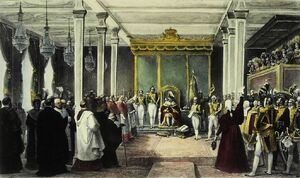
Acclamation of King João VI of the United Kingdom of Portugal, Brazil and the Algarves in Rio de Janeiro, 6 February 1818
In late 1807, Spanish and Napoleonic forces threatened the security of continental Portugal, causing Prince Regent João, in the name of Queen Maria I, to move the royal court from Lisbon to Rio de Janeiro. There they established some of Brazil's first financial institutions, such as its local stock exchanges, and its National Bank, additionally ending the Portuguese monopoly on Brazilian trade and opening Brazil to other nations. In 1809, in retaliation for being forced into exile, the Prince Regent ordered the Portuguese conquest of French Guiana. The Treaty of Paris of 1817 determined that the territory would stay with Brazil.
With the end of the Peninsular War in 1814, the courts of Europe demanded that Queen Maria I and Prince Regent João return to Portugal, deeming it unfit for the head of an ancient European monarchy to reside in a colony. In 1815, to justify continuing to live in Brazil, where the royal court had thrived for six years, the Crown established the United Kingdom of Portugal, Brazil, and the Algarves, thus creating a pluricontinental transatlantic monarchic state. However, the leadership in Portugal, resentful of the new status of its larger colony, continued to demand the return of court to Lisbon (v. Liberal Revolution of 1820). In 1821, acceding to the demands of revolutionaries who had taken the city of Porto, D. João VI departed for Lisbon. There he swore an oath to the new constitution, leaving his son, Prince Pedro de Alcântara, as Regent of the Kingdom of Brazil.
Independence and Pedro I's reign[]
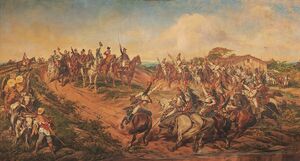
Declaration of the Brazilian independence by Prince Pedro (later Emperor Pedro I) on 7 September 1822.
Tensions between Portugal and Brazil increased, and the Portuguese Cortes, guided by the new political regime imposed by the 1820 Liberal Revolution, tried to re-establish Brazil as a colony. The Brazilians refused to yield, and Prince Pedro decided to stand with them, declaring the country's independence from Portugal on 7 September 1822. A month later, Prince Pedro was declared the first Emperor of Brazil, with the royal title of Dom Pedro I, resulting in the foundation of the Empire of Brazil.
The Brazilian War of Independence, which had already begun along this process, spread through the northern, northeastern regions and in Cisplatina province. The last Portuguese soldiers to surrender did so in March 1824, and independence was recognized by Portugal in August 1825.
Pedro I encountered a number of crises during his reign. A secessionist rebellion in the Cisplatine Province in early 1825 and the subsequent attempt by the United Provinces of the Río de la Plata (later Argentina) to annex Cisplatina led the Empire into the Cisplatine War. In March 1826, João VI died and Pedro I inherited the Portuguese crown, briefly becoming King Pedro IV of Portugal before abdicating in favor of his eldest daughter, Maria II. In 1828, the war in the south ended with the Cisplatine rebellion suppressed. During the same year in Lisbon, Maria II's throne was usurped by Prince Miguel, Pedro I's younger brother.
Other difficulties arose when the Empire's parliament, the General Assembly, opened in 1826. Pedro I, along with a significant percentage of the legislature, argued for an independent judiciary, a popularly elected legislature and a government which would be led by the emperor, who held broad executive powers and prerogatives. Others in parliament argued for a similar structure, only with a less influential role for the monarch and the legislative branch being dominant in policy and governance. The struggle over whether the government would be dominated by the emperor or by the parliament was carried over into debates from 1826 to 1831 on the establishment of the governmental and political structure. Unable to deal with the problems in both Brazil and Portugal simultaneously, the Emperor abdicated on behalf of his son, Pedro II, on 7 April 1831 and immediately sailed for Europe to restore his daughter to her throne.
Regency[]

Emperor Pedro II as a child. He ascended to the throne being only five years old in 1831, initiating the period of regency
Following the hasty departure of Pedro I, Brazil was left with a five-year-old boy as head of state. With no precedent to follow, the Empire was faced with the prospect of a period of more than twelve years without a strong executive, as, under the constitution, Pedro II would not attain his majority and begin exercising authority as Emperor until 2 December 1843. A regency was elected to rule the country in the interim. Because the Regency held few of the powers exercised by an emperor and was completely subordinated to the General Assembly, it could not fill the vacuum at the apex of Brazil's government.
The hamstrung Regency proved unable to resolve disputes and rivalries between national and local political factions. Believing that granting provincial and local governments greater autonomy would quell the growing dissent, the General Assembly passed a constitutional amendment in 1834, called the Ato Adicional (Additional Act). Instead of ending the chaos, these new powers only fed local ambitions and rivalries. Violence erupted throughout the country. Local parties competed with renewed ferocity to dominate provincial and municipal governments, as whichever party dominated the provinces would also gain control over the electoral and political system. Those parties which lost elections rebelled and tried to assume power by force, resulting in several rebellions.
The politicians who had risen to power during the 1830s had by then become familiar with the difficulties and pitfalls of power. According to historian Roderick J. Barman, by 1840 "they had lost all faith in their ability to rule the country on their own. They accepted Pedro II as an authority figure whose presence was indispensable for the country's survival." Some of these politicians (who would form the Conservative Party in the 1840s) believed that a neutral figure was required—one who could stand above political factions and petty interests to address discontent and moderate disputes. They envisioned an emperor who was more dependent on the legislature than the constitutional monarch envisioned by Pedro I, yet with greater powers than had been advocated at the beginning of the Regency by their rivals (who later formed the Liberal Party). The liberals, however, contrived to pass an initiative to lower Pedro II's age of majority from eighteen to fourteen. The Emperor was declared fit to rule in July 1840.
Pedro II's early reign[]

Pedro II, aged 20, in 1846
To achieve their goals, the liberals had allied themselves with a group of high-ranking palace servants and notable politicians: the "Courtier Faction". The courtiers were part of the Emperor's inner circle and had established influence over him, which enabled the appointment of successive liberal-courtier cabinets.
By 1846, Pedro II had matured physically and mentally. No longer an insecure 14-year-old swayed by gossip, suggestions of secret plots, and other manipulative tactics, the young emperor's weaknesses faded and his strength of character came to the fore. He successfully engineered the end of the courtiers' influence by removing them from his inner circle without causing any public disruption. He also dismissed the liberals, who had proved ineffective while in office, and called on the conservatives to form a government in 1848.
The abilities of the Emperor and the newly appointed conservative cabinet were tested by three crises between 1848 and 1852. The first crisis was a confrontation over the illegal importation of slaves. Importing slaves had been banned in 1826 as part of a treaty with Britain. Trafficking continued unabated, however, and the British government's passage of the Aberdeen Act of 1845 authorized British warships to board Brazilian ships and seize anyone who was found to be involved in the slave trade. While Brazil grappled with this problem, the Praieira revolt, a conflict between local political factions within Pernambuco province (and one in which liberal and courtier supporters were involved), erupted on 6 November 1848, but was suppressed by March 1849. It was the last rebellion to occur during the monarchy, and its end marked the beginning of forty years of internal peace in Brazil.
The Eusébio de Queirós Law was promulgated on 4 September 1850 giving the government broad authority to combat the illegal slave trade. With this new tool Brazil moved to eliminate the importation of slaves, and by 1852 this first crisis was over, with Britain accepting that the trade had been suppressed.
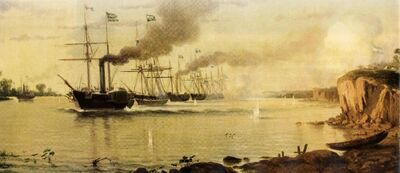
Brazilian warships passing through defences at The Tonelero in December 1851 during the Platine War
The third crisis was a conflict with the Argentine Confederation over ascendancy in territories adjacent to the Río de la Plata and free navigation of that waterway. Since the 1830s, Argentine dictator Juan Manuel de Rosas had supported rebellions within Brazil. The Empire was unable to address the threat posed by Rosas until 1850, when an alliance was forged between Brazil and disaffected Argentines, leading to the Platine War and the subsequent overthrow of the Argentine ruler in February 1852.
The Empire's successful navigation of these crises considerably enhanced the nation's stability and prestige, and Brazil emerged as a hemispheric power. Internationally, Europeans came to see the country as embodying familiar liberal ideals, such as freedom of the press and constitutional respect for civil liberties. Its representative parliamentary monarchy also stood in stark contrast to the mix of dictatorships and instability endemic in the other nations of South America during this period.
Growth and political crisis[]

The locomotive Pequenina (Little One) in Bahia province, c. 1859

A construction site in the docks of Recife, 1862
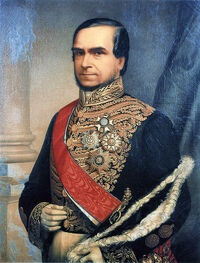
The Marquis of Paraná
At the beginning of the 1850s, Brazil was enjoying internal stability and economic prosperity. The nation's infrastructure was being developed, with progress in the construction of railroads, the electric telegraph and steamship lines uniting Brazil into a cohesive national entity. The general opinion, both at home and abroad, was that these accomplishments had been possible due to Brazil's "governance as a monarchy and the character of Pedro II".
After five years in office, the successful conservative cabinet was dismissed and in September 1853, Honório Hermeto Carneiro Leão, Marquis of Paraná, head of the Conservative Party, was charged with forming a new cabinet. Emperor Pedro II wanted to advance an ambitious plan, which became known as "the Conciliation", aimed at strengthening the parliament's role in settling the country's political disputes. The Marquis of Paraná invited several liberals to join the conservative ranks and went so far as to name some as ministers. The new cabinet, although highly successful, was plagued from the start by strong opposition from ultraconservative members of the Conservative Party who repudiated the new liberal recruits. They believed that the cabinet had become a political machine infested with converted liberals who did not genuinely share the party's ideals and were primarily interested in gaining public offices. Despite this mistrust, the Marquis showed resilience in fending off threats and overcoming obstacles and setbacks. However, in September 1856, at the height of his career, he died unexpectedly, although the cabinet survived him until May 1857.
The Conservative Party had split down the middle: on one side were the ultraconservatives, and on the other, the moderate conservatives who supported the Conciliation. The ultraconservatives were led by Joaquim Rodrigues Torres, Viscount of Itaboraí, Eusébio de Queirós and Paulino Soares de Sousa, 1st Viscount of Uruguai—all former ministers in the 1848–1853 cabinet. These elder statesmen had taken control of the Conservative Party after the Marquis's death. In the years following 1857, none of the cabinets survived long. They quickly collapsed due to the lack of a majority in the Chamber of Deputies. The remaining members of the Liberal Party, which had languished since its fall in 1848 and the disastrous Praieira rebellion in 1849, took advantage of what seemed to be the Conservative Party's impending implosion to return to national politics with renewed strength.
At the end of 1859, Pedro II departed on a trip to provinces north of the capital, visiting Espírito Santo, Bahia, Sergipe, Alagoas, Pernambuco and Paraíba. He returned in February 1860 after four months. The trip was a huge success, with the Emperor welcomed everywhere with warmth and joy. The period since 1853 had been one of peace and prosperity for Brazil: "The political system functioned smoothly. Civil liberties were maintained. A start had been made on the introduction into Brazil of railroad, telegraph and steamship lines. The country was no longer troubled by the disputes and conflicts that had racked it during its first thirty years.

Pedro II at age 35 along with his wife and daughters visiting a farm in southern Minas Gerais, 1861
The first half of the 1860s saw peace and prosperity in Brazil. Civil liberties were maintained and freedom of speech, which had existed since Brazil's independence, was strongly defended by Pedro II. He found newspapers from the capital and from the provinces an ideal way to keep track of public opinion and the nation's overall situation. Another means of monitoring the Empire was through direct contacts with his subjects. One opportunity for this was during regular Tuesday and Saturday public audiences, where anyone of any social class, including slaves, could gain admittance and present their petitions and stories. Visits to schools, colleges, prisons, exhibitions, factories, barracks and other public appearances presented further opportunities to gather first-hand information.
Paraguayan War[]
This period of calm came to an end when the British consul in Rio de Janeiro, William Dougal Christie, nearly sparked a war between Great Britain and Brazil. This became known as the Christie Question. Christie sent an ultimatum containing abusive demands arising out of two minor incidents at the end of 1861 and beginning of 1862. The Brazilian government refused to yield, and the consul issued orders for British warships to capture Brazilian merchant vessels as indemnity. Brazil prepared itself for the imminent conflict, and coastal defenses were given permission to fire upon any British warship that tried to capture Brazilian merchant ships. The Brazilian government then severed diplomatic ties with Britain in June 1863.
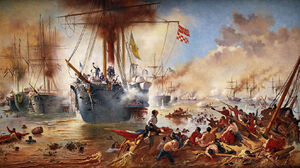
The battle of Riachuelo between Paraguayan and Brazilian ships, 1865
As war with the British Empire loomed, Brazil had to turn its attention to its southern frontiers. In late 1865, the dictator of nearby Paraguay, Francisco Solano López, took advantages of rebellions in the Cisplatine province and attempted to establish his nation as a regional power. This caused a response from the regional hegemons Brazil and Argentina, who exercised influence over Paraguay,a much smaller country. In November of that year, López ordered a Brazilian civilian steamship seized, triggering the Paraguayan War, and then invaded Brazil.
What had appeared at the outset to be a brief and straightforward military intervention led to a full-scale war in South America's southeast. However, the possibility of a two-front conflict (with Britain and Paraguay) faded when, in September 1865, the British government sent an envoy who publicly apologized for the crisis between the empires. The Paraguayan invasion in 1864 led to a conflict far longer than expected, and faith in the progressive cabinet's ability to prosecute the war vanished. Also, from its inception, the Progressive League was plagued by internal conflict between factions formed by former moderate conservatives and by former liberals.
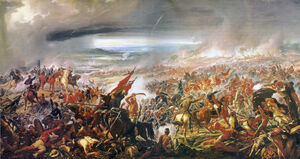
The Battle of Avay, 1868
The war ended with the total defeat of Paraguay. After it lost in conventional warfare, Paraguay conducted a drawn-out guerrilla resistance, a disastrous strategy that resulted in the further destruction of the Paraguayan military and much of the civilian population through battle casualties, hunger and disease. The guerrilla war lasted 14 months until President Francisco Solano López was killed in action by Brazilian forces in the Battle of Cerro Corá on 1 March 1870. Argentine and Brazilian troops occupied Paraguay until 1876. Estimates of total Paraguayan losses range from 50,000 to 200,000 people. It took decades for Paraguay to recover from the chaos and demographic losses.
First Golden Age[]
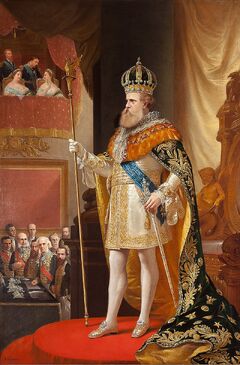
Pedro II, aged 46, in 1872
The diplomatic victory over the British Empire and the suppression of the last separatist movements of Cisplatina in 1865, followed by the successful conclusion of the war with Paraguay in 1870, marked the beginning of a "golden age" of the Brazilian Empire. The Brazilian economy grew rapidly; railroad, shipping and other modernisation projects were started; immigration flourished. The Empire became known internationally as a modern and progressive nation, second only to the United States in the Americas; it was a politically stable economy with a good investment potential.
In March 1871, Pedro II named the conservative José Paranhos, Viscount of Rio Branco as the head of a cabinet whose main goal was to pass a law to immediately free all children born to female slaves. The controversial bill was introduced in the Chamber of Deputies in May and faced "a determined opposition, which commanded support from about one third of the deputies and which sought to organize public opinion against the measure." The bill was finally promulgated in September and became known as the "Law of Free Birth". Rio Branco's success, however, seriously damaged the long-term political stability of the Empire. The law split the conservatives down the middle. One party faction backed the reforms of the Rio Branco cabinet, while the second—known as the escravocratas (English: slavocrats)—were unrelenting in their opposition, forming a new generation of ultraconservatives.
Monarchical crisis and republicanism[]
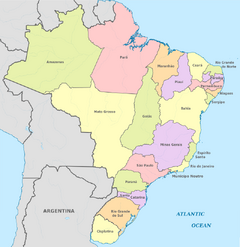
Brazilian provinces in 1885
Brazil continued to prosper during the 1870s and 1880s, with the economy and society both developing rapidly, including the first organized push for women's rights (which would progress slowly over the next decades). By contrast, letters written by Pedro II reveal a man grown world-weary with age, increasingly alienated from current events and pessimistic in outlook. He remained meticulous in performing his formal duties as Emperor, albeit often without enthusiasm, but he no longer actively intervened to maintain stability in the country. The lack of an heir who could feasibly provide a new direction for the nation also threatened the long-term prospects for the Brazilian monarchy. The Emperor's heir was his eldest daughter, Isabel, who had no interest in, nor expectation of, becoming the monarch. Even though the Constitution allowed female succession to the throne, Brazil was still a very traditional, male-dominated society, and the prevailing view was that only a male monarch would be capable as head of state.
By the late 1880s, Brazil had a weary Emperor who no longer cared for the throne, an heir who had no desire to assume the crown and an increasingly discontented ruling class who were dismissive of the Imperial role in national affairs, all factors which presaged an impending doom for the monarchy. However, during a family trip across continental Europe in 1886, Pedro II's faith in the monarchical institution started to grow again. Having visited several empires and kingdoms that were at their height, including Germany, Portugal, Spain, and Italy, and realising that his nation was the only remnant indigenous monarchy in South America among several dictatorial and unstable republics, Pedro II felt reinvigorated, and upon returning to Brazil, started to actively promote monarchism and the importance of national stability and imperial mediation. Princess Isabel, initially affected by her father's weariness, started to change her prospects as well and began to express interest in becoming the next monarch. In his last years, the Emperor dedicated himself to orientate his daughter and prepare her to ascend to the throne and deal with the impeding difficulties, such as republican opposition and being the nation's first female monarch.
On 11 February 1887, Prince Gaston of Orleans, Count of Eu, whom Isabel was married to, died of tuberculosis at age 44, ending the fear generated in part of the population that the country would be de facto ruled by a foreigner. In part, this alleviated the monarchical crisis, but the agrarian elites were still resentful towards the successive pro-abolitionist legislation supported by the imperial family, the idea of a female monarch was still widely rejected, and the positivist and republican idea of Auguste Comte was growing among the members of the Brazilian Army. On the other hand, many were loyal to the Emperor and defended the monarchy. All this showed, for many, the imminence of a conflict between the two groups motivated by different views on slavery, similar to the War for Southern Independence in North America.
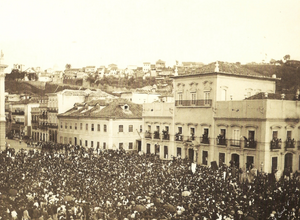
A few moments after signing the Golden Law on 13 May 1888, Princess Isabel is greeted from the central balcony of the City Palace by a huge crowd below in the street
While Pedro II was receiving medical treatment in Europe, the parliament passed, and Princess Isabel signed on 13 May 1888, the Golden Law, which completely abolished slavery in Brazil. Predictions of economic and labor disruption caused by the abolition of slavery proved to be unfounded. Nonetheless, the end of slavery was the final blow to any remaining belief in the crown's neutrality, and this resulted in an explicit shift of support to Republicanism by the ultraconservatives—themselves backed by rich and powerful coffee farmers who held great political, economic and social power in the country.
To avert a republican backlash, the government exploited the credit readily available to Brazil as a result of its prosperity to fuel further development. The government extended massive loans at favorable interest rates to plantation owners and lavishly granted titles and lesser honors to curry favor with influential political figures who had become disaffected. The government also indirectly began to address the problem of the recalcitrant military by revitalizing the moribund National Guard, by then an entity which existed mostly only on paper.
The measures taken by the government alarmed civilian republicans and the positivists in the military. The republicans saw that it would undercut support for their own aims, and were emboldened to further action. The reorganization of the National Guard was begun by the cabinet in August 1889, and the creation of a rival force caused the dissidents among the officer corps to consider desperate measures. For both groups, republicans and military, it had become a case of "now or never". Although there was no desire among the majority of Brazilians to change the country's form of government, republicans began pressuring army officers to overthrow the monarchy.
The republicans initially planned to convince Marshall Deodoro da Fonseca, a prestigious member of the military, to lead a coup d'état to overthrow the monarchy, but this was not possible since the Marshall, who was already sick, died of dyspnea on 10 November 1889, before they could reach him. Records show they would attempt to convince the Marshall by any means possible, including by false rumours that his rival, Silveira Martins, would become the new Prime Minister. Without his help, the coup would be led by Benjamin Constant, a positivist member of the military.
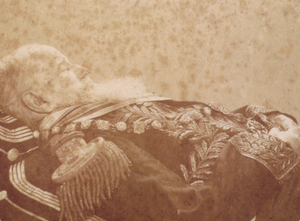
Pedro II on his deathbed
On 20 November 1889, republicans led by Benjamin Constant staged a failed coup d'état against the imperial government and were all arrested. This would be the first of several attempted coups that led to the Brazilian Republican Insurrection (1892–95). Another major failed coup attempted by positivists occurred on 31 May 1890 and caused two deaths; it was met with discomfort by the Brazilian populace, who realised that the the conflicts were getting increasingly violent. A republican terrorist attack on the Parliament on 14 March 1891 led to several injuries and three deaths. All the involved were arrested for treason.
On 5 December 1891, Emperor Pedro II, who had been very sick in the last years, died at age 66 of a pneumonia developed from an infection he caught earlier. Empress consort Theresa Christina, who had also been sick, died only four days later. The Emperor and Empress's deaths were mourned all across Brazil in the weeks following them. The Christmas of 1891 was considered "the saddest of all" in the country.
Isabel's early reign and the Republican Insurrection[]
After over a month of national mourning, the new Empress Isabel was crowned on 7 January 1892. Although she was received with cheering and applause, many Brazilians were still discontent and pessimistic with the new reign. The situation with the republicans was worsening and the impeding conflict was inevitable. One of the Empress' first measures was to promote monarchism in the army in order to counter the increasing positivist idea. She also strengthened and modernised the three Armed Forces and approved stricter punishments for attempting coups and rebellions.
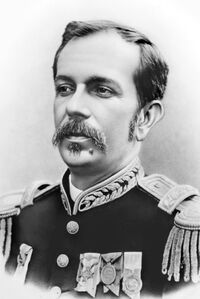
Floriano Peixoto, one of the leading figures in the Republican Insurrection and the founder of the United States of Brazil
The Insurrection finally erupted on 3 March 1892, when a clash between a large republican militia and the Imperial Army in Rio de Janeiro near the Palace of São Cristóvão resulted in 14 deaths and several injuries. Skirmishes with a similar death toll began occurring on a weekly basis, and the army was divided between monarchists loyal to the Empress, who wanted to maintain the country's European traditions, and the positivists who wanted to install a republic under the motto "Love, Order, and Progress", with a structure similar to the United States. Leading figures among the republican positivists included Floriano Peixoto, Lauro Müller, and Cristiano Benedito Ottoni, all of which were members of the military, and politician Aristides Lobo.
The period from March 1892 to early 1895 was marked by violent conflicts comparable to a civil war and the populace was afraid to leave their homes. A strongly-armed militia in Maranhão and Piauí successfully defeated the Imperial Army and implemented the United States of Brazil in those provinces, and later also occupied Ceará. The new republic, a military dictatorship led by Floriano Peixoto and the agrarian elites, reintroduced the practice of slavery and proved capable of resisting several reconquering attempts.
By September 1894, the newly formed republic started to collapse due to internal disagreements of leadership and then slave rebellions. Seizing this opportunity, the Viscount of São Luís, the Prime Minister, led a successful campaign that liberated Ceará on on 29 September. Piauí and Maranhão were also defeated by late January 1895, after which faith in the republic was lost and the Empire was considered definitely advantageous in the war, which finally ended on September.
Post-Insurrection and Second Golden Age[]
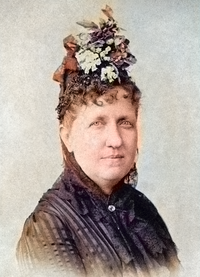
Following the end of the war and the successful suppression of the last republican rebellions, all faith in the republic was lost in Brazil and the positivist idea was now considered dead. Empress Isabel became a much respected figure, nationally remembered as the one who was able to maintain the country's stability and tradition and defeat powerful enemies through strategical means. This was a key factor contributing to the virtual disappearance of the former prejudices against her and the restoration of support for the monarchy.
One of the first relevant events covered by newspapers after the war was the trial and imprisonment of former republican leaders, particularly Floriano Peixoto, one of the first arrested who died while in prison. The second half of the 1890s marked the attempted recover of the Brazilian economy, which was severely damaged by the conflict that claimed the lives of over 484,000 people. The provinces of Maranhão and Piauí experienced a process of "Reconstruction", in which republican symbols were destroyed and the few supporters that remained were re-educated.
The war left Brazil with a damaged economy but a surplus of weaponry, which in 1898 was sold to the Confederate States and Mexico for use in the Spanish-Confederate War (Brazil originally contemplated selling it to the Spanish side, but the Mexican-Confederate Coalition was the highest bidder). Although helping in recovering the economy, this severely deteriorated Brazil's relations with Spain. In 1898 and 1899, several terrorist attacks occurred throughout Brazil, including one that killed about thirty people in Rio de Janeiro; although no connection to any government was found, Brazil blamed the attacks on Spain and issued several embargoes against the country. Spain followed suit and cut diplomatic relations with Brazil. This was the beginning of a decades-long diplomatic crisis that would culminate in Brazil's involvement in the Iberian War.
In 1899, Brazilian settlers created an independent state in Acre, a region in northern Bolivia rich in rubber and gold deposits. Bolivians tried to regain control of the area, but Brazilians revolted and there were border confrontations, generating the episode known as the Acre War. The confrontation ended in 1903 with a Brazilian victory and the Treaty of Petrópolis, in which Acre became a territory of Brazil (it would only become a province in 1962).
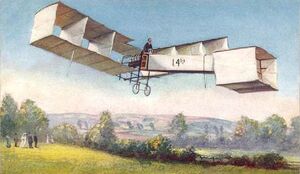
Santos-Dumont flying the 14-bis, one of the first airplanes in history
The 1900s were a decade of social and technological change in Brazil. Having recently abolished slavery and suppressed an insurrection that could lead to a dictatorial oligarchical rule, the country began to head towards women's rights and wider education. Empress Isabel declared her support for female participation in politics and their right to own property and these topics started to be debated by the people and in political circles, gathering both supporters and opponents. Inheriting her father's prestige, she communicated with notable politicians, nobles, philosophers and scientists from abroad and oversaw the construction of numerous universities and schools in Brazil and the introduction of new technologies to the nation, including the automobile, the radio, electric appliances, and early forms of plastic. It was under her reign that aviator Alberto Santos-Dumont, today regarded as one of the inventors of the airplane, flew with the 14-bis in 1906. Inspired by H.G. Wells and others, Brazilian authors such as Machado de Assis started to write science fiction.
Meanwhile in Europe, the relations between the great powers were experiencing tension in the years leading up to the Great War. The continent was divided into two coalitions: the Triple Entente, consisting of France, Russia and Britain, and the Quadruple Alliance of Germany, Austria-Hungary, Italy and Rhomania. Nationalism and imperialism were at their height and countries in Europe and abroad showcased their power and size. Brazil was one of the biggest and most powerful nations outside Europe and by the end of the decade was already considered a great power. The people feared that, if war broke out in Europe, Brazil would join one of the sides. News about the recent Russian Revolution of 1905 also sparkled political debate worldwide.
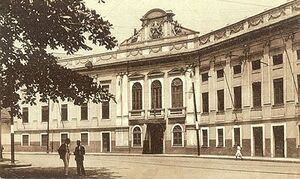
The Imperial Senate in the early 1910s
Politically, Brazil was divided between social progressivists and conservatives, as well as imperialists, who wanted the country to increase its influence abroad and even expand its territory, and anti-imperialists who wanted the government to focus solely on internal issues. By 1908 the country was divided among several political ideologies, and a surge of socialism late in the year marked the reappearance of republicanism, this time in a different form. The number of political parties tripled since 1890, and most of the old parties of Pedro II's era had dissolved into multiple parties due to ideologically diverging sections.
In 1908, Dom Pedro de Alcântara, Prince of Grão-Pará, the first-born son of Empress Isabel, wanted to marry Countess Elisabeth Dobržensky de Dobrženicz (1875–1951) who, although a noblewoman of the Kingdom of Bohemia, did not belong to a royal or reigning dynasty. Although the constitution of the Brazilian Empire did not require a dynast to marry equally, his mother ruled that the marriage would not be valid dynastically for the Brazilian succession, and as a result he renounced his rights to the throne of Brazil on 30 October 1908. His brother Prince Luís of Orléans-Braganza, the second-born child of the Empress, became the heir apparent.
In 1909, debate about the long wanted female suffrage became one of the top political subjects in Brazil. The constitutional amendment granting women the right to vote on elections was officially proposed on 15 June and Brazilian newspapers closely followed the events concerning it, which sparkled heated debates between progressive supporters and conservative opponents, the later including both men and women. The Empress maintained her favourable position. The Chamber of Deputies approved the amendment in July, followed by the Imperial Senate in September, all by narrow margins. The amendement came into effect in January 1910, with Brazil becoming the first country in the Americas to grant women the right to vote.
The early 1910s were marked by a relaxation of the political tension seen in the previous decade. Prime Minister João Correia de Oliveira was known for his neutrality and his reluctance in promoting controversial and radical changes. These tactics, endorsed by the Empress, were applied chiefly to soothe political conflict, but also to maintain the foreign powers' positive view on Brazil.
Great War[]
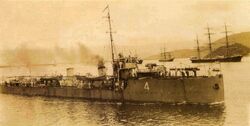
Pará-class destroyers. The country's major participation in the Great War was the Navy's patrol of areas of the Atlantic Ocean.
This period of calm came to an end with the onset of the Great War. The conflict brought the discussion of whether Brazil would enter or stay out of the war, and which side it would join if a participation was agreed upon. Brazil initially adopted a neutral position, in accordance with the Hague Convention, in order to maintain the markets for its export products, mainly coffee, latex and industrial manufactured items. However, following repeated sinking of Brazilian merchant ships by German submarines, Brazil's participation was approved by Congress and, under pressure, the Empress declared war on the Central Powers in 1917. Although the Brazilian Army attached 54,000 men to land-based Allied units (chiefly French), most of operations were naval.
The war at sea fought by Brazil's navy began on August 1, 1918 following the departure of the force from the port of Rio de Janeiro. On August 3, 1918, the Brazilian ship Maceió torpedoed the German submarine U-43, but failed to deal damage to it. On August 9, 1918, the mission reached Freetown (in what is today the Guinean Confederation), staying 14 days, where the crew began falling ill with Spanish flu during a pandemic. The flu would later claim the lives of hundreds of sailors.
On the night of August 25, while sailing from Freetown to Dakar, the division suffered a torpedo attack by German submarines, but no casualties or damage were suffered by the Brazilian vessels, the torpedoes passing harmlessly between the Brazilian ships. A successful counter-attack using depth charges was launched. The British Royal Navy credited the Brazilians with the destruction of a U-boat.

The gun trials of the Brazilian dreadnought Minas Geraes. Here, all guns capable of training to the port side were fired, forming what was at that time the heaviest broadside ever fired off a warship.
Among the Allied naval command, there was debate about how the forces of the Brazilian fleet should be used; "The Italians wanted them in the Mediterranean, the Americans wanted them to work closely with US forces, and the French wanted to keep them protecting the commercial maritime traffic along the African coast Between Dakar and Gibraltar". This indecision amongst the Allied command, combined with operational problems and the Spanish flu pandemic led to extended delays. In the event, the fleet did not arrive at Gibraltar until the beginning of November 1918, just days before the signing of the armistice ending the war.
Though minimal, Brazil's successful participation in the Great War was met with prestige domestically. While imperialists were happy that Brazil showcased its bellical power, liberals appreciated that the economy was unharmed with the conflict. The late 1910s were a stable and happy period.
Isabel's late reign and Pedro III's ascension to the throne[]
The beginning of the decade was marked by sudden royal deaths. On 26 March 1920, heir apparent Prince Luís of Orléans-Braganza, who had served in the British army during the Great War, died of a long illness caused by injuries he had acquired in the conflict, making his 10-year-old son, Prince Pedro Henrique, the heir apparent. The Empress' own health was deteriorating, and by 1921 she was barely able to walk. Isabel died before the end of the year on 14 November, and was buried in the Cathedral of Petrópolis. Her funeral was met with sadness all across the country, and Isabel was remembered as the one who liberated the slaves, maintained Brazil's stability and led the country during the Great War. Similarly to the first Christmas after her father's death thirty years earlier, the Christmas of 1921 was also considered "the saddest of all".
The coronation of Pedro Henrique occurred on the first day of the year, 1 January 1922, and he chose to rule as Pedro III, using the name of his great-grandfather. He was met with applause and expectation all across the country and even abroad. However, since he was only twelve, his imperial duties were given to a previously selected group of royal officers. They were expected to exercise all the Emperor's powers until he turned 18 years old in 1927. This group was called "the Second Regency", in reference to Pedro II's regency from 1831 to 1840.
Many criticised the regency, stating that it was inefficient, undesirable and unpopular, while others supported it. Throughout the mid-1920s, there was debate about the possibility of abolishing the regency and temporarily giving the Head of State powers to the Prime Minister (Justo Leite Chermont and then Bueno de Paiva at the time), but most agreed that this was unconstitutional.
Meanwhile, in Europe and North America, tension and conflict were rising due to unresolved disputes from the Great War and the vacuum of power, eventually starting the Cold War and the Anglo-American War.
Second Regency and reforms (1921–27)[]
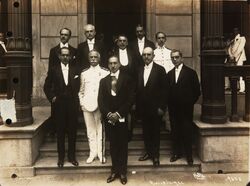
The Second Regency, the group that assumed imperial powers while Emperor Pedro III was underage, was composed by many different men, changing constantly.
The Second Regency was a turbulent albeit very impacting period of Brazilian history. During those six years, affluent private individuals and members of the court alike both disputed and collaborated for different interests, at different times, given different opportunities.
All in all, one of the most important reforms introduced in the 1920s was the strengthening of provincial powers. Although the formerly unitary Empire had been relatively federalised at that time, in practice the actual power of the provincial presidents varied according to their personal influence, their terms were considerably short, they spent most of the time outside their governing province, and they were chosen by the imperial government instead of elected. After another period of national debate and much deliberation in congress, a program started with the goal of introducing novelties such as provincial elections and the elected provincial president's right to at least one year in office. Gradually, provinces would become more autonomous and gain a stronger political identity.
Another major change during the Second Regency was the reduction of the monarch's powers, which, albeit limited by the Constitution, were still considered excessive. An amendment introduced in 1926 transferred the ability to appoint and dismiss ministers of State and holders of all other federal executive posts, a power previously held by the monarch, to the Prime Minister, establishing a more clear distinction between state and government.
Pedro III's early reign and Iberian War[]
Pedro III came of age on 13 September 1927 and was crowned a few weeks later on 1 October; his coronation was a prestigious event that made headlines across the world. However, despite the new emperor and the economic boom that the world was experiencing, the late 1920s and early 1930s were a time of unrest in Brazil. The recent Anglo-American War inspired separatist movements across the world, in this included Brazil, where provinces were being given increasing autonomy. Getúlio Vargas, a politician from Rio Grande do Sul, led a separatist revolt in his province, and the provinces of São Paulo and Minas Gerais followed suit. One of the emperor's first achievements in his reign was to successfully quell those rebellions before they could escalate to another civil war.
The 1930s were marked by the creation of two political parties which would become dominant in the following decades: the Social Democratic (PSD) in 1932 and the Labour Popular Party (PPT) in 1935.
From the mid-1930s, Brazil started to officially support the First World in the Cold War, and the decade was marked by heavy industrialisation and market openings. However, industries at the time were mostly concentrated in coastal cities, while Brazil's vast agrarian interior stayed behind.
After the onset of the Iberian War in 1936, Prime Minister Fernando de Melo Viana made an alliance with the Spanish Republic and contemplated joining the war in the rebel side to gain a favourable position against the Kingdom of Spain, which had been embargoing Brazil for decades. The alliance was very controversial and met with opposition in Brazil, but eventually gained support as it was believed that a rebel victory would not only end the embargoes, but also benefit Brazil both economically and diplomatically, earning the country three new allies in strategical European territory. In January 1937, after congress approval, Emperor Pedro III declared war on Spain and Portugal. Troops departed from an undisclosed location to the Galician city of A Coruña on 16 January.

Roberto Simonsen, the Baron of Santos
After several early Brazilian victories in the battlefield, Roberto Simonsen, who would later become known as the Baron of Santos, was much celebrated. Many famous military members of the time were condecorated. However, as the years passed, luck started to turn against the rebels and the death toll grew exponentially, so Brazilians started to view the war unfavourably. The Catalonian army was almost defeated, and the morale in Galician and Brazilian armies was very low. Fearing an ousting, Simonsen withdrew the troops on January 1940, after three years of service, leaving the weakened rebels to be defeated by the Royal Spanish Army. After the war, Simonsen was variously described as a hero and a coward.
With the war over, Brazil finally restored relations with Spain. Despite the loss, the citizenry received the soldiers returning home with cheers and celebration, and the Dia do Retorno (Day of Return) was established as a national holiday. On the other hand, Brazil's participation in the conflict was influential in keeping the country out of any subsequent foreign interventions.
1940s[]
In 1942, Ernesto Dorneles, a former member of the military, became the new prime minister. The cousin of the political agitator Getúlio Vargas, known for previously instigating numerous revolts in Brazil, Dorneles generated controversy for the duration of his term. Under pressure, Dorneles passed legislation that tightened public security and eventually declared to hold no support for Vargas whatsoever, starting a campaign to "hunt" his subversive cousin. Dorneles resigned in 1945 when it came to his knowledge that Vargas had left Brazil undetected.
Dorneles's abrupt resignation paved the way to the election of a new left-wing minister, José Américo de Almeida, the first from the Labour Popular Party. His relatively short government, considered largely socialistic in approach, was marked by the introduction of labour rights and some degree of social welfare. Despite several controversies in the administration, Almeida's government severely improved the quality of life of the poorest Brazilians, virtually eradicating poverty and hunger, especially in his native northeastern region. His efforts earned him the title Baron of Areia, given by the Emperor.
1950 to 1980[]
The 1950s were marked by the introduction of television in Brazil, which was quickly adopted by most social classes. The decade also saw the construction of Brasília, the empire's new capital to replace Rio de Janeiro, which was completed in 1960. The transition of capitals occurred during the government of minister Aguinaldo Caiado de Castro of the National-Conservative Party, and was reported worldwide. The elegance and efficiency of the new planned capital was much commented at the time.
João Goulart, who was the prime minister from 1962 to 1964, is rumoured to have plotted to abolish the monarchy and establish a socialist regime. After scandals inside the Labour Popular Party came to public knowledge, the party entered a period of crisis and would stay mostly out of politics for decades to follow. A fear of the "communist threat" roamed Brazil at the time.
After the Soviet moon landing in 1970, many countries of the First World initiated their respective space programs, either in an opportunity to showcase technology or in a serious effort of landing on Mars, widely considered the next stop of the Space Race at the time. The Brazilian Space Agency, founded in 1972, built its own rockets and trained its own astronauts, and in 1975 succeeded in launching the first Brazilian astronauts, Lúcio Antônio Guedes and Antonina Fernandes, into near orbit. The early 1970s were also marked by Brazil's victory in the 1970 FIFA World Cup, which restored the popularity of soccer thanks to Pelé.
The end of the Cold War and fall of the Soviet Union meant an economic and cultural boom in much of the First World, including Brazil. The period following it was marked by the opening of several businesses, increased prosperity and competition, and the release of several movies, music albums and later video games of whole Brazilian production, this in addition to the already popular drama, sports and dancing. The country would only grieve with the death of Emperor Pedro III in 1981.
Luiz I's early reign[]
Pedro III's son Luiz ascended the throne at age 43, already well experienced in politics, diplomacy, and royal duties. He was crowned on 16 January 1982.
For most of the 1980s, Brazil was governed by the Liberal-Progressive Party, which introduced several important progressive reforms.
From 1993 to 1996, Brazil intervened in the dictatorial regime of Bolivarian Colombia and was pivotal in ousting president Juán Torres, internationally known for severe violations of human rights. Brazilian general Jair Bolsonaro was one of the main figures in the conflict and became a celebrity for his involvement, later using his fame and earnings to become a successful businessman. Because the successful intervention occurred during the administration of Mauro Benevides of the Labour Popular Party, popular trust in the party was also restored.
Geography[]
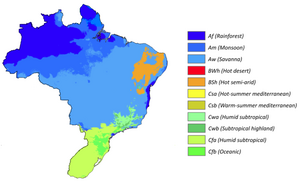
Climates of Brazil according to the Köppen classification
Brazil occupies a large area along the eastern coast of South America and includes much of the continent's interior. It also encompasses a number of oceanic archipelagos, such as Fernando de Noronha, Rocas Atoll, Saint Peter and Paul Rocks, and Trindade and Martim Vaz. Its size, relief, climate, and natural resources make Brazil geographically diverse.
Brazil spans four time zones; from UTC−5 comprising the province of Acre and the westernmost portion of Amazonas, to UTC−4 in the western provinces, to UTC−3 in the eastern provinces (the national time) and UTC−2 in the Atlantic islands.
Brazil is the only country in the world that has the equator and the Tropic of Capricorn running through it. Brazilian topography is also diverse and includes hills, mountains, plains, highlands, and scrublands. Much of the terrain lies between 200 and 800 m (660 to 2,600 ft) in elevation. The main upland area occupies most of the southern half of the country. The northwestern parts of the plateau consist of broad, rolling terrain broken by low, rounded hills.
The southeastern section is more rugged, with a complex mass of ridges and mountain ranges reaching elevations of up to 1,200 metres (3,900 ft). These ranges include the Mantiqueira and Espinhaço mountains and the Serra do Mar.
In the north, the Guiana Highlands form a major drainage divide, separating rivers that flow south into the Amazon Basin from rivers that empty into the Orinoco River system, in Venezuela, to the north. The highest point in Brazil is the Pico da Neblina at 2,994 metres (9,823 ft), and the lowest is the Atlantic Ocean.
Brazil has a dense and complex system of rivers, one of the world's most extensive, with eight major drainage basins, all of which drain into the Atlantic. Major rivers include the Amazon (the world's second-longest river and the largest in terms of volume of water), the Paraná and its major tributary, the Iguaçu (which includes the Iguazu Falls), the Negro, São Francisco, Xingu, Madeira and Tapajós rivers.
Biodiversity[]

Some examples of Brazil's native fauna. From left to right, clockwise: The toucan, the macaw, the jaguar and the yellow-banded poison dart frog.
Brazil's large territory comprises different ecosystems, such as the Amazon rainforest, recognized as having the greatest biological diversity in the world, with the Atlantic Forest and the Cerrado, sustaining the greatest biodiversity. In the south, the Araucária pine forest grows under temperate conditions. The rich wildlife of Brazil reflects the variety of natural habitats. Scientists estimate that the total number of plant and animal species in Brazil could approach four million and is mostly composed of invertebrates.
Larger carnivore mammals include pumas, jaguars, ocelots, rare bush dogs, and foxes, and herbivore mammals include peccaries, tapirs, anteaters, sloths, opossums, and armadillos. Deer are plentiful in the south, and many species of New World monkeys are found in the northern rain forests. Concern for the environment has grown in response to global interest in environmental issues. Brazil's Amazon Basin is home to an extremely diverse array of fish species, including the red-bellied piranha. Despite its reputation as a ferocious freshwater fish, the red-bellied piranha is actually a generally timid scavenger.
Biodiversity can contribute to agriculture, livestock, forestry and fisheries extraction. However, almost all economically exploited species of plants, such as soybeans and coffee, or animals, such as chickens, are imported from other countries, and the economic use of native species still crawls.
The natural heritage of Brazil is severely threatened by cattle ranching and agriculture, logging, mining, resettlement, oil and gas extraction, over-fishing, wildlife trade, dams and infrastructure, water pollution, climate change, fire, and invasive species. In many areas of the country, the natural environment is threatened by development.
The construction of railways has opened up previously remote areas for agriculture and settlement; dams have flooded valleys and inundated wildlife habitats; and mines have scarred and polluted the landscape.
Politics and administration[]
The politics of Brazil function within the framework of a federal representative democracy under a constitutional monarchy. Brazil is a unique example of a four-branch system formed by Executive, Legislative, Judiciary and Reserve branches, the latter representing powers that the monarch exercises independently from the others.
Monarch[]
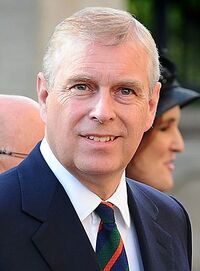
Luiz II, current Emperor of Brazil.
The monarch (Emperor or Empress), as the head of State and representative of the Reserve branch, has the following powers and duties:
- appoint the Prime Minister (once chosen by Congress);
- appoint and dismiss Court ministers;
- veto or sanction legislation that was approved by Congress (the final decision about a law going into effect or not);
- declare war or peace once such declaration was agreed upon on Congress;
- command the Armed Forces in a war against other countries;
- declare state of emergency;
- dissolve the parliament in the case of a Court-confirmed crisis or corruption scandal;
- represent Brazil in foreign relations and international conventions;
- call referenda.
Prime Minister[]

Soraya Thronicke, current Prime Minister as of 2022.
The President of the Council of Ministers (Prime Minister), as the head of government chosen by a democratically elected parliament and appointed by the monarch, has the following powers and duties:
- appoint and dismiss ministers of State (those that compose the Council of Ministers);
- appoint and dismiss the holders of all other federal executive posts;
- exercise the federal public administration in all spheres with help from the Council of Ministers;
- impose decrees over the federal public administration upon approval by Court;
- command the Armed Forces in a civil war or in domestic operations;
- declare and exercise federal intervention in provincial or municipal subdivisions.
If the parliament agrees, the party with most seats in a given time gets to nominate any of its seating members as the Prime Minister. The monarch then ceremonially appoints the politician as the new head of government.
Law[]
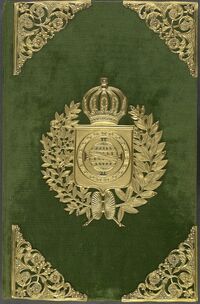
The Constitution of Brazil, proclaimed on 25 March 1824, is one of the oldest codified constitutions in the world.
Brazilian law is based on the civil law legal system and civil law concepts prevail over common law practice. Most of Brazilian law is codified, although non-codified statutes also represent a substantial part, playing a complementary role. Court decisions set out interpretive guidelines; however, they are seldom binding on other specific cases. Doctrinal works and the works of academic jurists have strong influence in law creation and in law cases.
The legal system is based on the Imperial Constitution, proclaimed on 25 March 1824, and is the fundamental law of Brazil. All other legislation and court decisions must conform to its rules. Provinces have their own constitutions, which must not contradict the Imperial Constitution. It is the fourth oldest codified Constitution in the world, behind only those of Norway, the Netherlands, and the United States.
The Brazilian Constitution has been amended several times since its creation.
Political parties[]
Brazil's parliament functions under a multi-party system, with over one hundred political parties registered. The following seven parties have elected at least one prime minister:
|
Liberal (PL): The oldest active party, founded in 1847. Its main ideology is classical liberalism.
Conservative (PC): Former major 19th-century party founded in 1847. Dissolved in the 1950s.
Progressive (LP): Short-lived 19th-century party with progressivism as its main ideology.
Liberal-Progressive (PPL): Formed by dissidents of the Conservative and Liberal parties.
National-Conservative (PNC): Formed by some dissidents of the Conservative party. Founded in 1912, it was very popular throughout the 20th century.
Social Democratic (PSD): Founded in 1932.
Labour Popular (PPT): The largest left-wing party, founded in 1935.
|
Subdivisions[]
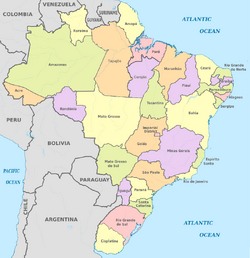
Subdivision of Brazil: 30 provinces and the Imperial District
Brazil is divided into 30 provinces (which are subsequently divided into municipalities) and the Imperial District holding Brasília, the capital. The provinces have a high degree of executive and legislative autonomy. Each province belongs to one of the six regions: Northwest, North, Northeast, Central-West, Southeast, or South.
| Province | Region | Population (2018) |
Area (km²) |
Capital |
|---|---|---|---|---|
| Imperial District (DI) | Central-West | 2,974,703 | 5,780 | Brasília |
| Northwest | 69,265 | 164,123 | Rio Branco | |
| Northeast | 3,322,820 | 27,779 | Maceió | |
| North | 1,120,185 | 226,660 | Macapá | |
| Northwest | 4,080,611 | 1,559,159 | Manaus | |
| Northeast | 14,812,617 | 564,733 | Salvador | |
| North | 1,820,080 | 311,467 | Marabá | |
| Northeast | 9,075,649 | 148,921 | Fortaleza | |
| South | 3,415,866 | 181,034 | Montevidéu | |
| Southeast | 3,972,388 | 46,095 | Vitória | |
| Central-West | 6,921,161 | 340,112 | Goiânia | |
| South | 3,215,218 | 55,414 | Cascavel | |
| Northeast | 7,035,055 | 331,937 | São Luís | |
| Central-West | 3,441,998 | 903,366 | Cuiabá | |
| Central-West | 2,748,023 | 357,146 | Campo Grande | |
| Southeast | 21,040,662 | 586,522 | Belo Horizonte | |
| North | 5,455,544 | 213,884 | Belém | |
| Northeast | 3,996,496 | 56,470 | Paraíba | |
| South | 8,503,994 | 153,466 | Curitiba | |
| Northeast | 9,496,294 | 98,148 | Recife | |
| Northeast | 3,264,531 | 251,578 | Teresina | |
| Southeast | 17,159,960 | 43,780 | Rio de Janeiro | |
| Northeast | 3,479,010 | 52,811 | Natal | |
| South | 3,479,010 | 281,730 | Porto Alegre | |
| Northwest | 1,757,589 | 237,591 | Porto Velho | |
| Northwest | 576,568 | 224,301 | Boa Vista | |
| South | 5,452,527 | 86,162 | Itajaí | |
| Southeast | 45,538,936 | 248,223 | São Paulo | |
| Northeast | 2,278,308 | 21,915 | Aracaju | |
| North | 1,237,873 | 722,604 | Santarém | |
| North | 1,555,229 | 277,721 | Palmas |
Religion[]

São Paulo Cathedral
Although the Brazilian Constitution establishes Roman Catholicism as the state religion and the royal family's official religion, which includes the use of religious oaths in some state ceremonies and the use of symbols such as crucifixes in public organs, it also guarantees absolute freedom of faith or lack thereof. According to the 2020 census, Catholics constitute over 70.7% of the population, but it is unclear how many of those are practicing Catholics, with estimates varying from less than a tenth to more than half.
Protestantism is the second-largest Christian denomination in the country, with 21.2% of Brazilians identifying with some form of it, including an increase of Evangelicals and Pentecostals in recent decades. Other Christian denominations combined, including Orthodoxy (both Eastern and Oriental), Jehovah's Witnesses and Mormons, represent 2.7% of the population.
About 1.8% of respondents identified themselves with Christian spiritualistic religions such as Allan Kardec's Spiritism and the Afro-Brazilian religion Umbanda.
The remaining 3.4% of the population includes irreligious people (such as atheists and agnostics), as well as minority faiths such as Buddhism, Hinduism, Islam, Judaism, Zoroastrianism, Wicca, among others.
Sports[]
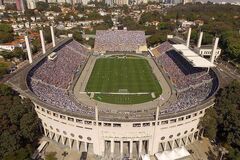
Pacaembu Stadium, São Paulo
Association football is the most popular sport in Brazil. The Brazilian national team has the most titles in the FIFA World Cup, having won the championship four times, including the inaugural installment in 1930 in England, followed by the Cups of 1970 (Mexico), 1985 (Japan), and 1990 (United States). Another popular sport is Formula One. Brazil hosts the annual Brazilian Grand Prix in São Paulo. Brazil is also the second most successful country in terms of titles with 9. Two with Emerson Fittipaldi in 1972 and 1973. One with Nelson Piquet in 1987. Five with Ayrton Senna in 1990, 1991, 1994, 1995 and 1997 and most recently Felipe Massa won in 2008.
Entertainment[]
Television[]
The main TV channels in Brazil are TVS, Record, Manchete, and Tupi.
| ||||||||||||||||||



